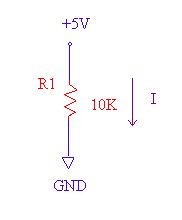
Figure 1.
- Using a multimeter, measure the actual resistance of the 10K ohm resistor (before building the circuit).
- Build the circuit in Figure 1 on the protoboard. With the multimeter set to measure DC volts, measure the voltage across the resistor.
- One method used to measure the current through a resistor is to use Ohm's Law. Using the data you collected from 2a and 2b, calculate the current, I, through the resistor. Express your answer in milliamps. This is your experimental value.
- Calculate the percent difference between the value for I you obtained in 2c, and the theoretical value for I you calculated in problem 1. Write your answer here.
- Another method used to measure current through a resistor is to "break" your circuit, and insert the multimeter into it to complete the connection. Measure I using the multimeter. Write your answer here.
- Calculate the percent difference between the value for I you obtained in 2e and the theoretical value for I you calculated in problem 1.


Figure 2.
- Using a multimeter, the DC voltage across each circuit element.
- Using Ohm's Law, calculate the values for all the indicated currents in the circuit.
- Using Kirchoff's Current Law, write node equations for the currents entering and leaving Nodes 1, 2, and 3.
- Using Kirchoff's Voltage Law, write loop equations for the three loops in the circuit.
- Calculate the power delivered or absorbed by all circuit elements (Ps, P1, P2, P3, and P4). Show that the Law of Conservation of Power is observed by showing that power is balanced for the circuit.